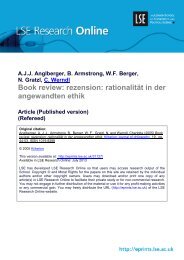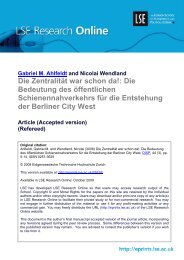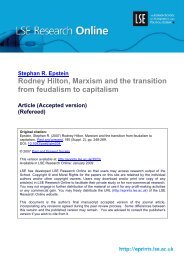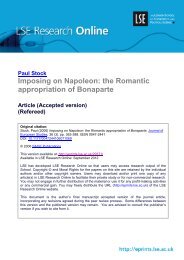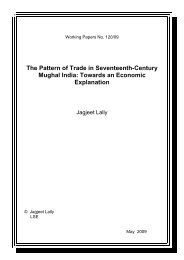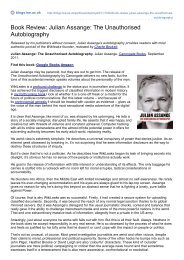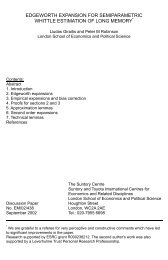Download (307Kb) - LSE Research Online
Download (307Kb) - LSE Research Online
Download (307Kb) - LSE Research Online
You also want an ePaper? Increase the reach of your titles
YUMPU automatically turns print PDFs into web optimized ePapers that Google loves.
networks can be shut down. A political economy perspective on these developments<br />
suggests that while ‘audiences’ are comprised of globally networked users who appear<br />
to derive pleasure from social networking, new forms of immaterial labour performed<br />
passively using Facebook or actively using Amazon’s Mechanical Turk are offering firms<br />
a basis for targeting their content in ways that are inconsistent with a level competitive<br />
playing field (Coté and Pybus, 2007), and that are unrelated to the symbolic content of<br />
the<br />
media.<br />
What kind of mediated public sphere?<br />
Concerns about the transformation of the audiovisual media industries are connected<br />
with prevailing ideas about the relation between a mediated public sphere and<br />
democracy (Calhoun, 1992). In the Habermasian public sphere, a democratic polity<br />
emerges as a result of the quality of discourse and the level of participation. The<br />
mediated environment is expected to create spaces for consensus formation. In contrast<br />
to this view, Mouffe (1999: 746) argues that this conception of the public sphere<br />
downplays the contested interests of citizens. It ‘consists in replacing the market‐<br />
inspired view of the public sphere by another conception that conceives political<br />
questions as being of a moral nature and therefore susceptible of being decided<br />
rationally’. She suggests that the public sphere should be structured so as to<br />
acknowledge diversity and difference, to allow passionate debate, and to provide for<br />
conflicts<br />
among adversaries to be expressed.<br />
In this view, the interpenetration of the audiovisual media with democratic processes<br />
suggests that mediation has the power to frame issues, to prime people through<br />
cultivation and to engage in agenda setting. As Silverstone (1999: 143) observed, ‘it is all<br />
about power, of course. In the end’. In this context, therefore, there is little doubt that<br />
the structure of the media matters – if it squeezes spaces for the contestation of views in<br />
the interests of profit or in the interests of the state, policy measures are needed which<br />
are not based primarily on issues of market share and commercial performance.<br />
A consequence of the information society vision as indicated above is the bias towards<br />
markets. Although content regulation has not been abandoned completely it is discussed<br />
in terms of market value (Tambini and Cowling, 2004). The result is that the European<br />
Commission requires Member States to use ‘public value tests’ and market impact<br />
assessments to determine the scope of activities of public service broadcasters. viii The<br />
10





